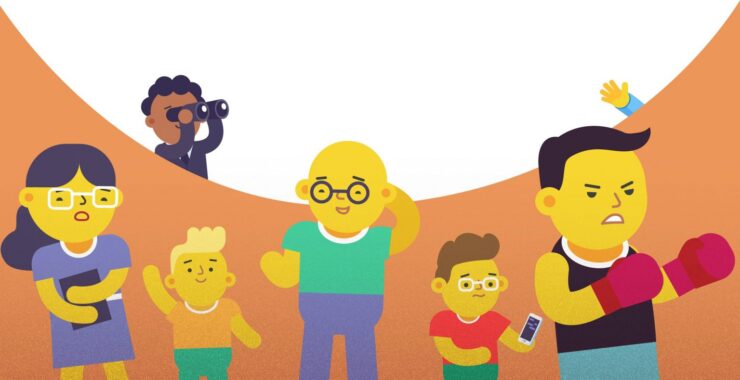Interpersonal communication is the process of sharing information, ideas, and opinions between two or more people. It makes teams bond stronger, get to know each other, and find solutions to problems if there are any.
Effective communication and identification of nonverbal cues when having meetings or hot discussions are essential. We often try to hide our emotions, feelings, and ideas but our bodies still send some subtle messages.
Establishing relationships on a professional and personal level requires effective communication abilities. Verbal communication and nonverbal communication are the two main categories and this blog will focus mainly on the non-verbal aspect of communication. Understanding non-verbal communication – such as body language, facial expressions, and gestures – can significantly enhance interpersonal interactions.
Nonverbal communication is frequently unintentional but may reveal a great deal about individuals and situations, even though most of us are aware of it and utilize it frequently.
Learning the types of nonverbal communication means that you can get better at reading body language. While it may seem odd, we all display behaviors that have the same function during stressful situations and not only. Emotions are universal and transcend cultural boundaries, highlighting the importance of mastering non-verbal cues in our communication toolkit. By honing these skills, you can more skilfully navigate interpersonal dynamics and foster deeper connections with others.
What is nonverbal communication?
Nonverbal communication is body language, gestures, tone of voice, facial expressions, body posture, etc, used for conveying information. But why are these wireless cues so important to identify?
Body language is an essential part of communication and it helps you send an emotion or feeling to other people.
Depending on how you sound and act, you can put people at ease, draw them to you, build trust, or make them afraid or have a negative impression on you.
Body language is a key part of communication that is important not only in a personal area when talking with your family, spouse, or children.
It is essential in your job too. Business people and managers get huge benefits if they are aware of non-verbal communication. It helps you:
– better communicate your ideas, opinions, and emotions
– better connect with others
– build stronger bonds
– increase trust and clarity
And all these benefits are of huge help when you lead a team and work with many stakeholders.
Meaning of nonverbal communication
Have you ever wondered how non-verbal communication really helps? Let’s take a look at real-life nonverbal communication examples.
The Marketing Manager at Chanty is always given recognition for her presentation skills. We asked our co-workers and executives why they praised her presentations. The answer we got was because of her exceptional nonverbal communication skills. Her body language conveyed clarity and trust, and she had a propensity to make eye contact.
In the practical world, the best teachers, actors, lawyers, TV hosts, journalists, or salespeople usually exhibit great nonverbal communication examples.
The most important things in communication are the things that you don’t hear but rather see. This encapsulates the significance of nonverbal communication.
According to a report by ResearchGate, 80% of communication is nonverbal. We communicate our deepest feelings of hope, joy, rage, despair, and anxiety without using words.
Nonverbal communication is becoming increasingly important and people around the world are even taking workshops to improve their nonverbal cues.
10 Examples of nonverbal communication
There are numerous examples of nonverbal communication. In this article, we are going to focus on ten main types that we believe are important. Let’s take a look at them below.
Facial expressions
One important thing that many people are not aware of is that facial expressions are universal. If you have watched the series Lie to Me, you already know that there are seven basic emotions.
These are sadness, anger, disgust, fear, surprise, contempt, and happiness. Even though our cultures can shape our worldviews and behaviors, facial expressions are universal throughout the world.
There are over 50 studies that have shown that these facial expressions are spontaneous and cannot be consciously controlled. Further research discovered micro-expressions, which are different from macro or facial expressions. When we are happy, fearful, or sad. In the presence of our closest ones, we do not have any reason to take them back or hide them.
However, when we go through different events, we might be tempted to do this. For example, in the case of a public speaking situation, fear, shame, anxiety, and other negative emotions creep through your body. You will be tempted to hide them because of what people may think about you.
No matter how much we think that we can hide our feelings, they come to the surface in the way of microexpressions. They are difficult to identify and you need training and exercise because they are quick and fleeting.
Gestures
There are many types of gestures. We all know that some of them are deliberate, such as waving or pointing, while others are not.
For example, there are adapting gestures such as touching some body parts, rings, clicking pens, and so on. They are often displayed when someone is in distress. During a presentation, you can notice that some speakers will adopt this kind of gesture.
There are also illustrator gestures, maybe one of the most natural ones. They are used subconsciously and illustrate the verbal message.
Posture and movement
Posture and movement are key factors of body language. Most people will adopt comforting behaviors or actions during stressful moments.
Posture and movement can tell you how someone is feeling. For example, an arm-crossed posture sends the message that you are not open to new ideas or solutions.
Or, the leg-crossed posture is known as a posture of defiance and defensiveness. Posture and movement send information about attitude.
Paralinguistics
Nonverbal communication is a broad field that includes all the subtleties of our bodies. Paralinguistics is represented by your tone of voice, pitch, loudness, and inflection.
Think about how the meaning of a sentence can be changed just by how you pronounce and articulate different words. Misunderstandings can arise from small things, like not hearing a word correctly.
For example, the words affect and effect have different meanings, but sound very similar. Fortunately, in most cases, we can use context and body language to discern between the two.
You can identify how the other is feeling just by carefully listening to what and how he presents his ideas. A cold tone of voice is related to negative emotions, while a warm one to more positive ones.
Eye gazing
Eyes are the window to the soul. And they never lie. We all know this. Eye contact is used in a conversation by everyone because it helps you gather information. It also helps you get feedback from the environment and notice the body language of your interlocutor.
However, eye contact helps us establish a connection with others. I have learned during my practice as a psychology student that when people gaze, I must not interrupt them. Gazing means that someone is deep thinking. Eye contact means that someone is ready to communicate and to listen to you.
Eyes can also be used to send different signals as well. Depending on the culture and society you live in, prolonged eye contact can send a signal of intimidation. Or, in another context, flirting.
Nevertheless, eyes can help someone establish a rapport or connection. And this is so important in the life of a businessman or manager.
Appearance
Nonverbal communication is also thought to be facilitated by the colors we wear, the clothes we dress up in, the haircuts we have, and other physical characteristics.
Research into the psychology of color shows that different colors can evoke different emotions. Physiological reactions, judgments, and conclusions can all be influenced by appearance.
Just consider all the rapid and subconscious judgments you make about people based solely on their appearance. Because first impressions matter, experts advise job seekers to dress professionally for interviews with potential employers as well.
Culture has a big impact on how people evaluate appearances. While being thin is often admired in Western culture, certain African societies associate fuller figures with better social standing, wealth, and health.
Artifacts
Other means of nonverbal communication include objects and imagery. You might choose an avatar in an online forum, for instance, to represent your identity there and to share information about who you are and what you like.
People frequently invest a lot of effort in creating an image for themselves and surrounding themselves with items that serve as symbols of the things that are significant to them.
For instance, uniforms can be used to send a great deal of personal information. A security guard will wear a uniform, a doctor will wear a white lab coat, and a student may wear a specific uniform to represent a certain school.
These costumes make it clear to onlookers what a person does for a living or where they belong.
Personal space
Have you ever experienced awkwardness during a conversation because the other person was intruding on your personal space? Although our needs for physical space vary depending on culture, circumstance, and the depth of the relationship, we are all there.
Physical space can be used to convey a variety of nonverbal cues, such as expressions of closeness and sympathy, dominance, or hostility. The typical conversational distance for Americans is between an arm’s length and four feet.
In American society, having less room can lead to either increased intimacy or hostile conduct. A person who has had their personal space invaded by another may feel intimidated as a result and may respond defensively.
Visual communication
Visual communication is any form of professional communication that relies on visual aids. For instance, we use a red sign to signify “danger,” a skull between two pieces of bone arranged crosswise to symbolize “hazard,” and an image of a lit cigarette with a cross on it to imply “no smoking.” Common techniques also include icons, infographics, and color-coded signals, which can simplify complex ideas for immediate understanding.
In business, visual communication — through charts, graphs, and diagrams — enhances presentations and improves comprehension across different audiences. By integrating these elements, communicators can make their messages more memorable and overcome language barriers by using universally recognized symbols to reinforce key points.
Environment
The psychological and physical aspects of the synchronous communication setting also fall under the environment. The setting is a crucial component of the dynamic communication process, more so than the desks and chairs in an office. One’s perspective of their surroundings affects how they respond to them.
For instance, Google is renowned for its work environment, which includes areas designed for physical activity and even 24-hour in-house food service. Although the cost is unquestionably high, Google’s actions speak for themselves. The outcomes achieved in the setting intended to promote contact, collaboration, and innovation are worthwhile.
Couple more words on nonverbal communication
Nonverbal communication, also known as body language or nonverbal cues, is something present in every moment of our lives. It’s a form of communication that often speaks louder than words and can offer valuable insights into others’ thoughts, emotions, and intentions.
The way you sit, talk, gesticulate, or walk can send subtle but powerful messages. Both macro and micro expressions are universal indicators of emotion, often common across cultures. Observing these expressions can help you understand others on a deeper level.
Body language is important for everyone. By paying attention to non-verbal communication cues, you can become more adept at reading social situations and adjusting your behavior accordingly. This skill not only helps you make stronger connections but also makes the process of supporting and helping others more natural and empathetic.
We communicate meaning and information to others through nonverbal cues, and we also perceive the activities of people around us by observing their body language, gestures, and other nonverbal signals.
When examining such nonverbal behaviors, it’s crucial to take the activities in groups into account. Understanding group dynamics and picking up on subtle non-verbal signals can provide further clarity about the overall mood and unspoken messages within the group. You can learn a lot about someone’s true intentions by observing their facial expressions, physical appearance, and tone of voice in addition to what they say.
What’s your opinion on this topic? Do you think body language is important? Leave a comment and let’s discuss it.









Add comment